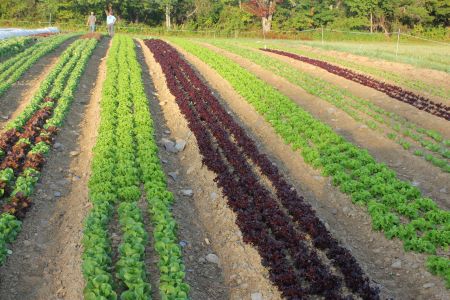How To Plan Your Garden For Producing The Most
If you’re a gardener, you know how wonderful it is to harvest the fruits (or veggies!) of your hard work, right?!
Sure you can grab your seeds and throw them out there, walk away, and then come back hoping for food. And you won’t be wrong, I’m sure there will be some food there!
But, one of the key successes to growing a garden and making it produce maximally is careful planning using succession plantings.
I always say that good planning is what makes us successful farmers, not the actual farming part. Haha! You can make up for so, so, so much with good planning, even poorer than ideal soil, shady conditions, and unfavorable weather events, among other deterrents.
Check out my ideas below to help you plan your best garden yet!
How to plan your vegetable garden for producing the most
In May it is sooooo common for people to ask us, “Have you got your garden in yet?” I’m sure you’ve heard that before, right?
Well, it’s always a toughie to answer because our garden isn’t really “in” until we finish planting... in August!
What?? August? Isn’t that practically when most people’s gardens are just about wrapping up?
Yes, but it doesn’t have to be that way!
In fact, by paying attention to this important factor, you can produce much more than you think from your garden!
How to set up succession plantings to increase your yield
It can be confusing when you look in seed catalogs and see “days to maturity” or “days to harvest”. What does that mean?
We certainly were perplexed when we first started planning our farm’s gardens over a decade ago. How do I know when to plant what??
In seed catalogs they will list a "Days to Harvest" number - this is usually days to harvest (or days to maturity) from your own date of transplanting. For a few crops, like baby salad greens, or radishes, or carrots, things that are direct seeded, the number listed is days to maturity from direct seeding.
So the shorter the number of days, the less time it requires in the garden to make a crop. Like take radishes for example. They are often 21-28 days to maturity. Which means you can plant them and 4 weeks later they're ready to harvest. Then you can pull them out and plant something else in the same year!
We use the "days to maturity" number as a starting place to plan out when crops will be ready to harvest and when we will have more room in our garden to put in something new!
Here’s a basic plan that keeps succession plantings in mind
May is when the snow should all be gone and the soil should start warming up. You can plant a few very hardy things as early as early May, but I do recommend waiting until the soil warms up more towards the end of May.
Here is a link to my blog post that has planting dates for all the popular vegetables. For the most part June 1 is always a good date to shoot for.
Once July rolls around, hopefully you’ll start to have something to show for your hard work. Your garden will be big, with things green and growing. This is the time to start thinking about succession planting. Why?
Because I would guess there would be a number of vegetables that are finishing up or not producing much anymore. These would be the vegetables you planted in May/early June that you are able to harvest after 4 weeks and over a couple weeks thereafter. Then they slow waaaaaay down or start to “bolt” or “go to seed”. In this category there are thinks like lettuce heads, baby greens, cilantro, and radishes.
If this is the case, July is a good time to sow these same things again for a second harvest later in the summer. So if you're going to be prepared, that means you need seeds ready to put in in July.
Mid-summer succession crop ideas: Early July is a great time to direct seed:
- carrots,
- beets,
- baby greens,
- cilantro,
- radishes,
- lettuce heads,
- bush beans,
- cucumbers,
- summer squash/zucchini,
- cabbage,
- broccoli,
- turnips,
- rutabaga,
- other greens like kale, Swiss chard, pac choi, etc.
- You can even plant a fall planting of peas if you want to!
Pro tip: Even though we don’t have succession seedlings available to buy then, it is warm enough for you to grow your own! In early June, you can grow your own seedlings by tucking seeds close together in a row a couple feet long, grow them on for about four weeks, then transplant them to their final location and spacing. But you need to start a month ahead of when you want to transplant them. This is advanced technique, and just so you know, direct seeding all of the above crops is just FINE in early July! It’s totally warm enough and they still have enough time to mature!
Late-summer succession crops: Early August is a great time to do another succession of the shortest season stuff like:
- baby greens,
- cilantro,
- radishes,
- salad turnips,
- daikon radish and other storage radishes,
- kale, chard, and other greens like pac choi.
Yes you really CAN grow a garden to maximize your season, even in Maine. Even in Northern Maine! :)
Learning to let go
No I’m not a therapist, but hear me out. I understand! Likely the hardest thing to get around as a gardener is letting go. Letting go of such beautiful plants that you worked hard to plant, tend, and enjoy eating. Just unceremoniously pulling them out!? Saying goodbye!?
It is sometimes still hard for us as farmers, but over the years, we’ve learned that once a plant passes it’s peak production, it’s time to let go.
The cycle can grow again in the same year! More beautiful things can grow in that same spot!
Examples include:
- Lettuce heads going to seed are past their prime.
- Bean plants put on a strong couple flushes and then peter out to not much.
- Broccoli brings forth it’s beautiful heads, and then the plants are done.
- Instead of continuing to put your limited energy and garden space into those plants after their peak, try succession planting something else for additional harvests!
Interested?
To plan your garden for producing the most, it's helpful to think ahead of time about these three things:
- What you'll be ready to pull out in July and even August.
- What you would most enjoy taking care of and eating in August, September and October.
- How to be prepared to let go and refresh your garden with some new seeds (and/or seedlings).




Add new comment